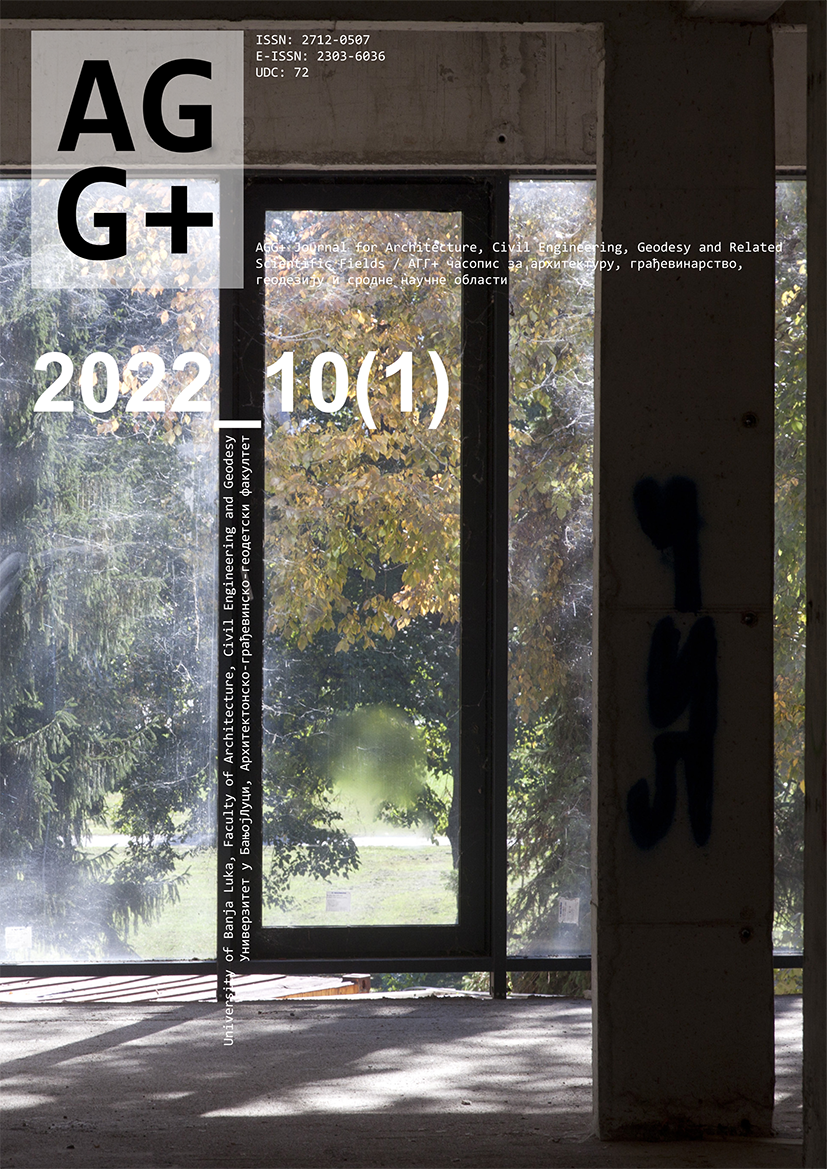Thermal Landscapes: Rahm's Meteorological Architecture
DOI:
https://doi.org/10.7251/AGGPLUS/2210018KKeywords:
meteorology, thermal places, atmospheres, post-critical, pace experienceAbstract
In this paper, we will consider the issue of climate discourse, which is consistently connected with the emergence of the meteorological approach in the theory and practice of contemporary architecture and urban design. Thermal modernity appears as a contemporary space of critical debate that expands the possibilities of architectural thinking, positioning it in a transdisciplinary knowledge framework. The concept of meteorology is the result of research on biological and ecological causes and processes, thermal factors, actions, and interactions to establish a sensory connection of users with space. Therefore, invisible spatial qualities, atmospheres, are recognised as ontologically important elements of spatial experience. The new paradigm opposes visual dominance, formalism, and semiological interpretations, establishing a new way of social and environmental responsibility.
References
H. Heynen, “A Critical Position for Architecture” in J. Rendell, J. Hill, M. Fraser, M. Dorrian, (eds.) Critical Architecture, New York: Routledge, 2007, pp. 48-56
S. Malpas, P. Wake “The Routledge Companion to Critical Theory”, New York: Routledge, 2006
G. Baird, “Criticality and its Discontents”, in A. Graafland, L. Kavanaugh, G. Baird (eds.), Crossover: Architecture, Urbanism, technology, Rotterdam: 010 Publishers, 2006, pp. 648−459.
W. Gropius, “Grundstaze der Bauhausproduktion“, in Ulrich Conrad (ed.), Programme und Manifeste zur Architectur des 20. Jahrhunderts, Braunschweig: Bauwelt Fundamente, 1926, pp. 90−92.
L. M. Van de Rohe, “Die neue Zeit“, in Ulrich Conrad (ed.), Programme und Manifeste zur Architectur des 20. Jahrhunderts, Braunschweig: Bauwelt Fundamente. 1930, pp. 114−115.
R. Shusterman, Thinking Through the Body: Essays on Somaesthetics, New York: Cambridge University Press. 2012
M. Jarzombek, „Critical or Post-Critical?“, Architectural Theory Review 7(1) 2002, pp. 149−151.
R. Somol and S. Whiting, “Notes around the Doppler Effect and Other Moods of Modernism”, Perspecta, Vol. 33, The MIT Press on behalf of Perspecta, 2002 pp. 72-77.
S. Sörlin and M. Lane, "Historicizing climate change—engaging new approaches to climate and history", Climatic Change, vol. 151, no. 1, pp. 1-13, 2018. Available: https://doi.org/10.1007/s10584-018-2285-0. [Accessed 14 July 2022]
K. Fløttum, "A linguistic and discursive view on climate change discourse", ASp, no. 58, pp. 19-37, 2010. Available: https://doi.org/10.4000/asp.1793 [Accessed 15 July 2022].
K. Anderson, "Vladimir Janković. Confronting the Climate: British Airs and the Making of Environmental Medicine. (Palgrave Studies in the History of Science and Technology) New York: Palgrave Macmillan, 2010, Isis, vol. 103, no. 3, pp. 590-591 Available: https://doi.org/10.1086/668990 [Accessed 15 July 2022].
I. Requena-Ruiz, "Building Artificial Climates. Thermal control and comfort in Modern Architecture (1930-1960)", Ambiances, no. 2, 2016, Available: 10.4000/ambiances.801 [Accessed 21 July 2022].
D. M. Peers, “Thomas Richards. The Imperial Archive: Knowledge and the Fantasy of Empire.” New York: Verso. 1993. Pp. viii, 179. ISBN 0-86091-605-7,” Albion, vol. 27, no. 3, pp. 555–556. . Available: https://archive.org/details/imperialarchivek0000rich/page/88/mode/2up [Accessed 15 July 2022].
L. Galiano and G. Fernández, Fire and Memory: On Architecture and Energy, MIT Press, 2000.
T. Pillon,“Le corps et l’air artificiel.” Communications, vol. 81, n°1, 2007 p. 85-100.
Available: 10.3406/comm.2007.2460 [Accessed 17 July 2022].
M. Kobi, "Keeping Warm in Subtropical Winter", Cahiers de la recherche architecturale, urbaine et paysagère, no. 6, 2019. Available: https://doi.org/10.4000/craup.2880 [Accessed 17 July 2022].
S. Healy, "Air-conditioning and the ‘homogenization’ of people and built environments", Building Research & Information, vol. 36, no. 4, pp. 312-322, 2008. Available: https://doi.org/10.1080/09613210802076351 [Accessed 19 July 2022].
Lj. Blagojević and D. Ćorović, “Uticaj klimatskih promena na planiranje i projektovanje I.” Univerzitet u Beogradu - Arhitektonski fakultet, 2011. Available: ISBN 978-86-7924-065-1 [Accessed 23 July 2022].
Č. Dženkins, Nova paradigma u arhitekturi: Jezik postmodernizma, Prevod Marijana Milosavljević. Orion Art, Beograd (in English), 2007, pp 228–231
P. Rahm, "Meteorological Architecture", Architectural Design, vol. 79, no. 3, pp. 30-41, 2009. Available: https://doi.org/10.1002/ad.885 [Accessed 25 July 2022].
M. Bluemink, "Foam Cities: Peter Sloterdijk's Atmospheric Philosophy", Academia Letters, 2021. Available: https://doi.org/10.20935/AL2814 [Accessed 01 August 2022].
A. Betsky, “Out There. Architecture Beyond Building: 11th International Architecture Exhibition La Biennale di Venezia”, 3rd ed. Marsilio, 2008.
C. Spence, "Senses of place: architectural design for the multisensory mind", Cognitive Research: Principles and Implications, vol. 5, no. 1, 2020. Available: https://doi.org/10.1186/s41235-020-00243-4 [Accessed 01 August 2022].
P. Rahm, "Digestible gulf stream: Architecture as meteorology, architecture as gastronomy - Philippe Rahm architectes", Philipperahm.com, 2022. [Online]. Available: http://www.philipperahm.com/data/projects/digestiblegulfstream/index.html. [Accessed: 02 Aug 2022].
G. Böhme, Atmospheric Architectures: The Aesthetics of Felt Spaces, Bloomsbury Publishing Plc, (in English), London, 2017.
L. Madsen and K. Gram-Hanssen, "Understanding comfort and senses in social practice theory: Insights from a Danish field study", Energy Research & Social Science, vol. 29, pp. 86-94, 2017. Available: 10.1016/j.erss.2017.05.013 [Accessed 03 August 2022].
G. Böhme, C. Borch, O. Eliasson, J. Pallasmaa, “Atmospheres, Art, Architecture: A Conversation between Gernot Böhme, Christian Borch, Olafur Eliasson, and Juhani Pallasmaa”, editor, Architectural Atmospheres: On the Experience and Politics of Architecture. Basel: Birkhäuser Verlag, p. 91-107, 2014
P. Rahm, "Domestic astronomy - Philippe Rahm architectes", Philipperahm.com, 2022. [Online]. Available: http://www.philipperahm.com/data/projects/domesticastronomy/index.html. [Accessed: 05- Aug- 2022].
G. Bachelard, The Poetics of Space, 3rd ed. Boston: Beacon Press, 1969, p. 65.
Rahm, "Jade Eco Park - Philippe Rahm architectes", Philipperahm.com, 2022. [Online]. Available: http://www.philipperahm.com/data/projects/taiwan/index.html. [Accessed: 05- Aug- 2022].
P. Chiambaretta, "The emergence of a new sense of spatiality", Pca-stream.com, 2022. [Online]. Available: https://www.pca-stream.com/en/articles/the-emergence-of-a-new-sense-of-spatiality-61. [Accessed: 05 Aug 2022].
S. Roesler, "3 Democratizing Urban Nature", City, Climate, and Architecture, pp. 75-112, 2022. Available: https://doi.org/10.1515/9783035624168-005 [Accessed 6 August 2022].
L. Heschong, Thermal Delight in Architecture, 5th ed. Cambridge: MIT, 1979, p. 46.

